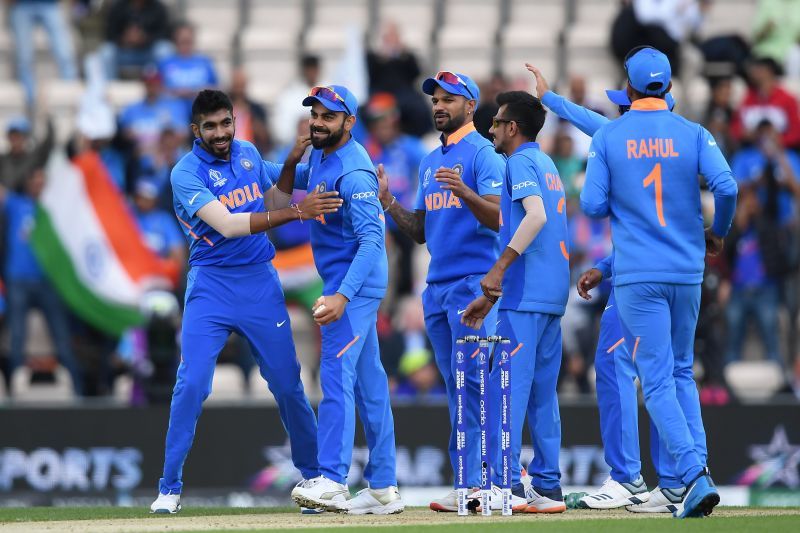
Indian cricket team's opening bowling gambit still a huge worry
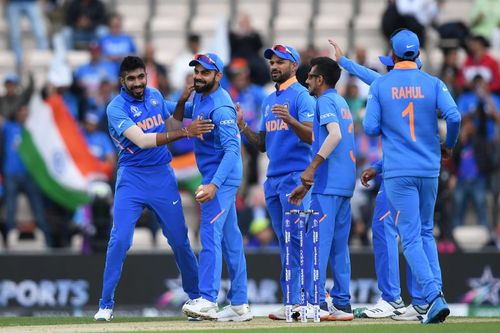
On 20th July 2021, the Indian cricket team pulled another victory out of the fire, with Bhuvneshwar Kumar and Deepak Chahar guiding the Men In Blue in a tense run-chase against Sri Lanka. The result, apart from being a glowing assessment of the Indian cricket team’s enviable depth, also ensured that the visitors notched up their 9th consecutive ODI win in Sri Lanka.
And, of course, they took an unassailable lead in the ongoing three-match series, having barely broken into a sweat, barring the second innings at the R Premadasa Stadium on Tuesday.
Understandably, the hype and fanfare has revolved around how the Indian cricket team has generated a group of players, who aren’t just fearless but also have the tactical nous to outwit the opposition. Rahul Dravid, the interim head coach in particular, has received plenty of praise for his role in nurturing these youngsters.
Over the course of the opening two ODIs, the Indian cricket team haven’t just been better than their Sri Lankan counterparts in almost all departments, they’ve also done so with the ruthlessness usually associated with top-drawer teams – something that vindicates their decision to send a completely different squad to the Emerald Isle.
Among all the positive furore, though, there is one aspect that has arguably flown under the radar, for it hasn’t really had as much of an impact against Sri Lanka. Yet it is certainly an element the Indian cricket team need to be mindful of. Not just because it has become a worrying trend over the past couple of years, but also because it could undermine everything good they do elsewhere.
Since the start of 2020, the Indian cricket team hasn’t really endured a purple patch in ODI cricket. The Men In Blue have played 14 ODIs (including 2 against Sri Lanka in the ongoing series) and have emerged victorious on only 7 occasions.
While those have included tough assignments against Australia (home and away), England (home) and New Zealand (away), the aforementioned is hardly befitting of a side boasting as much quality as the Indian cricket team.
In a major chunk of the aforementioned matches, the Indian cricket team has simply failed to make inroads at the outset – something that has pushed them on the back foot frequently. And, the numbers are rather damning, especially with the resources the Men In Blue have at their disposal.
Indian cricket team has a dismal bowling record in the Power Play since 2020
In the period between January 2020 and July 2021, the Indian cricket team has accounted for 7 batters in the Power Play across 14 ODIs. In blunter terms, they’ve averaged a solitary wicket every two games, meaning that opposition batters have gotten themselves set and have subsequently launched assaults.
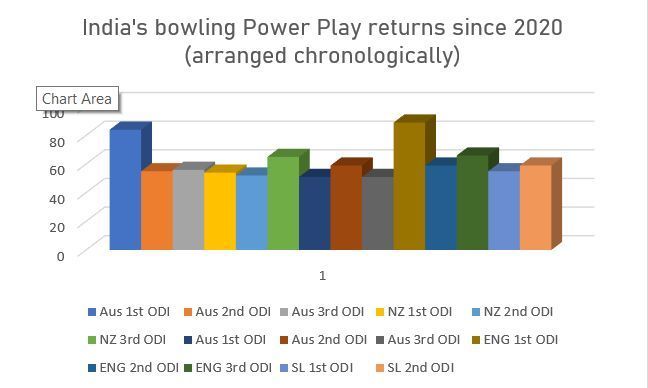
If one were to delve a little further, the Indian cricket team has bagged just 9 wickets in the Power Play in their previous 20 ODIs.
As far as fortunes in the Power Play are concerned, the Indian cricket team has not been able to keep a lid on the run-scoring too, with them having conceded more than 50 runs every time they’ve bowled in an ODI since 2020.
In fact, the Indian cricket team’s record against opening batters (since 2020) is pretty abysmal, at best. They average 81 with the ball, having seen these batters plunder 1539 runs across 14 matches. And, they sit comfortably atop that pile, which, to be honest, isn’t something to write home about.
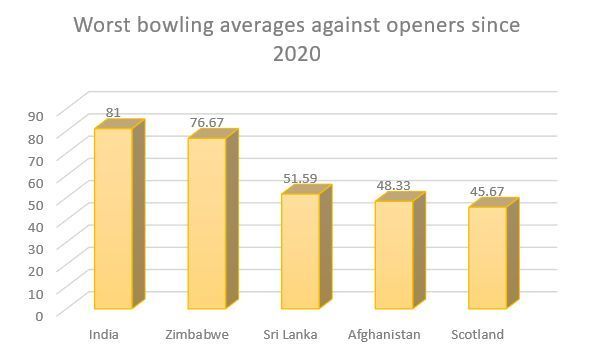
During the aforementioned phase, India have also not managed to contain the opposition to a score below 250, with England’s tally of 251 in the 1st ODI at Pune in March 2021 being the lowest score.
Rather alarmingly, on 11 of the 14 occasions, the opposition has gotten up to totals in excess of 270, which even in the modern-age, represents a competitive tally. Incredibly, the Indian cricket team’s mauling by Australia at the Wankhede Stadium in January 2020, when the Aussies annihilated the hosts, is not a part of the 11, for they chased down 256 (inside 38 overs).
In the process, the Indian cricket team has suffered on the bowling front and has often had to contend with chasing totals that wouldn’t have been deemed ideal. While the initial inclination would be to term this as an anomaly and reason that the Indian cricket team has seldom put together its first-choice bowling attack lately, the root of the problem may not lie in the personnel, at all.
Since the beginning of 2020, almost all of the Indian cricket team’s premier fast bowlers have played some part. Astonishingly, Bhuvneshwar Kumar and Mohammed Shami (two wickets apiece) are the only ones to have taken two wickets or more.
Of the three other wickets that the Indian cricket team have taken in the Power Play, one was a run-out, with T Natarajan (against Australia at Canberra) and Yuzvendra Chahal (against Sri Lanka at Colombo) being the other beneficiaries.
Jasprit Bumrah, quite remarkably, last took a Power Play wicket in the semi-final of the 2019 ICC Cricket World Cup, when Martin Guptill nibbled at a delivery in the channel and was caught spectacularly by Virat Kohli at second slip. Since then, the Mumbai Indians speedster has played nine ODIs but has not dismissed a single batter in the first ten overs.
Thus, there is no evidence to suggest that the Indian cricket team has been lacking on the personnel front. Instead, it seems to be a combination of slightly defensive bowling and field placements that have probably led to this aberration.
Though the white-ball does not offer a lot of assistance for pacers, the Indian cricket team have been content to bide their time. In fact, they’ve been more accustomed to preying on the batter’s mistakes, rather than trying to prize open the game themselves. For it to happen though, the Indian cricket team must be willing to ship a few runs, for it could lead to wicket-taking opportunities.
To an extent, the amount of pressure exerted pays dividends. However, it comes with a massive caveat, for top-notch teams such as Australia, England and New Zealand usually don’t wither away the advantage accumulated. Against Sri Lanka, it has worked a charm. That, though, could be down to the Islanders’ incompetency in the middle phases.
Since 2019, Sri Lanka average 30.26 in overs 11-40, meaning that they regularly lose momentum. On the other side of the spectrum are Australia, England and New Zealand – sides that average 54.44, 43.92 and 46.03 in the corresponding phase, respectively.
To that end, the bowling statistics of Kuldeep Yadav, Ravindra Jadeja and Yuzvendra Chahal also showcase a similar decline. Kuldeep’s career average stands at 28.34. Since 2020, though, it spikes up to 72.25. Similarly, Chahal and Jadeja have skewed averages, with the former possessing a tally of 30.58 (as opposed to 26.93) and the latter having an average of 67.42 (as opposed to 37.36).
The economy rates, meanwhile, also change pretty drastically. Each of Chahal, Kuldeep and Jadeja have higher economy rates during this period - 6.22, 6.56 and 5.36, in contrast to overall ERs of 5.2, 5.22 and 4.92, respectively. The above can partly be attributed to the lack of wickets in the Power Play – something that puts more pressure on the spinner and allows opposition batters to target them.
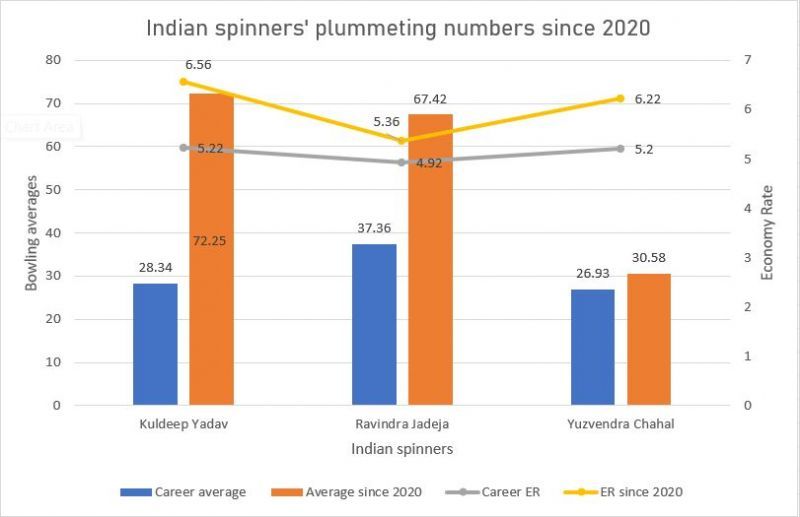
Thus, there is enough to hint that the Indian cricket team would inevitably struggle against sides that are strong in the middle phases, especially if they don’t pick up wickets early. Unfortunately, that has been the case since 2020 and the Indian cricket team’s ODI fortunes have relatively plummeted.
While the Indian cricket team, owing to their embarrassment of riches, have usually offset it, it still is a predicament that they would rather want to avoid. Against sides of Sri Lanka’s ilk, the Indian cricket team might still be able to pull victories out of the fire, just like they did on Tuesday at Colombo.
Yet, there would remain a sinking feeling that the Indian cricket team’s opening bowling gambit, which has somehow fallen off a cliff, is a massive worry and one that would, ultimately, catch up with them.